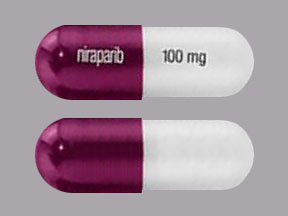Niraparib Interactions
There are 620 drugs known to interact with niraparib, along with 5 disease interactions, and 1 alcohol/food interaction. Of the total drug interactions, 47 are major, 449 are moderate, and 124 are minor.
- View all 620 medications that may interact with niraparib
- View niraparib alcohol/food interactions (1)
- View niraparib disease interactions (5)
Most frequently checked interactions
View interaction reports for niraparib and the medicines listed below.
- Abraxane (paclitaxel protein-bound)
- Aceta (acetaminophen)
- Acidophilus Probiotic Blend (lactobacillus acidophilus)
- Adriamycin (doxorubicin)
- Akynzeo (netupitant / palonosetron)
- Anoro Ellipta (umeclidinium / vilanterol)
- Aspirin Low Strength (aspirin)
- Ativan (lorazepam)
- Augmentin (amoxicillin / clavulanate)
- Avastin (bevacizumab)
- Bactrim (sulfamethoxazole / trimethoprim)
- Cabometyx (cabozantinib)
- Calcarb (calcium carbonate)
- Calcium, Magnesium and Zinc (multivitamin with minerals)
- Centrum Adults (multivitamin with minerals)
- Claritin (loratadine)
- Culturelle Digestive Health (lactobacillus rhamnosus gg)
- Cymbalta (duloxetine)
- Eliquis (apixaban)
- Levothroid (levothyroxine)
- Lynparza (olaparib)
- Metamucil (psyllium)
- Metoprolol Succinate ER (metoprolol)
- Morphine Sulfate IR (morphine)
- Paracetamol (acetaminophen)
- Tylenol (acetaminophen)
- Vitamin B12 (cyanocobalamin)
- Vitamin C (ascorbic acid)
- Vitamin D3 (cholecalciferol)
- Xanax (alprazolam)
Niraparib alcohol/food interactions
There is 1 alcohol/food interaction with niraparib.
Niraparib disease interactions
There are 5 disease interactions with niraparib which include:
More about niraparib
- niraparib consumer information
- Compare alternatives
- Reviews (63)
- Side effects
- Dosage information
- During pregnancy
- Drug class: PARP inhibitors
- Breastfeeding
- En español
Related treatment guides
Drug Interaction Classification
| Highly clinically significant. Avoid combinations; the risk of the interaction outweighs the benefit. | |
| Moderately clinically significant. Usually avoid combinations; use it only under special circumstances. | |
| Minimally clinically significant. Minimize risk; assess risk and consider an alternative drug, take steps to circumvent the interaction risk and/or institute a monitoring plan. | |
| No interaction information available. |
See also:
Further information
Always consult your healthcare provider to ensure the information displayed on this page applies to your personal circumstances.


